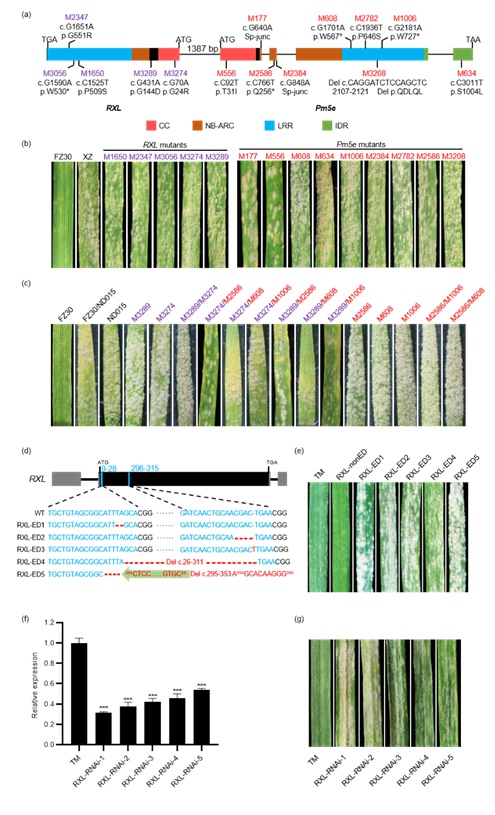Wheat powdery mildew, caused by Blumeria graminis f. sp. tritici (Bgt), is a widespread disease that leads to yield losses of approximately 10%-40%. Developing resistant wheat varieties using powdery mildew resistance genes is a key strategy to reduce pesticide dependence in agriculture. Most of the cloned powdery mildew resistance genes encode CNL (CC-NLR) proteins. CNLs, such as Arabidopsis ZAR1 and wheat Sr35, can form a wheel-like pentameric complex known as the resistosome, in which the CC domain inserts into the plasma membrane and acts as a Ca²⁺ channel, triggering the influx of Ca²⁺ to activate immune responses.
In most cases, a single NLR protein can simultaneously recognize effector molecules from pathogens and initiate immune responses. However, some NLRs function as NLR pairs, where the sensor NLR recognize the pathogen effectors through its integrated domain, and the other NLR in the pair, known as the executor NLR or helper NLR, is responsible for initiating the immune response. These NLR pairs are often tightly linked in the genome, such as the RGA4/RGA5 and Pik-1/Pik-2 in rice, and the RPS4/RRS1 in Arabidopsis. However, it is unclear whether NLR pairs regulate disease resistance in wheat.
To tackle this challenges, a team led by Professor LIU Zhiyong from the Institute of Genetics and Developmental Biology (IGDB), Chinese Academy of Sciences (CAS), in collaboration with Jonathan Jones’ team from The Sainsbury Laboratory (TSL) in the UK, HAN Guanzhu’s team from Nanjing Normal University, and HU Tiezhu’s team from Henan University of Science and Technology, published a research paper titled ‘The wheat NLR pair
RXL/
Pm5e confers resistance to powdery mildew’ online in the
Plant Biotechnology Journal (
http://doi.org/10.1111/pbi.14584).
This study used various research methods to demonstrate that two tightly linked NLR (nucleotide-binding and leucine-rich repeat) genes, RXL and Pm5e, which are in a head-to-head orientation, function as an NLR pair to mediate powdery mildew resistance in wheat. Both RXL and Pm5e encode atypical NLR proteins, with RXL containing a truncated NB-ARC domain and Pm5e featuring an atypical CC domain.
Further research showed that RXL and Pm5e prefer to form a heteromeric complex, and the CC domain of Pm5e can competitively interact to specifically suppress the HR (hypersensitive response) triggered by the CC domain of RXL, revealing the possible regulatory mechanism of this NLR pair. The RXL/Pm5e orthologs evolved from a pre-existing head-to-head pair before the divergence of Triticeae through phylogenetic analyses.
This study firstly demonstrates that NLR pairs mediate disease resistance in wheat and uncover the molecular mechanism of RXL/Pm5e in regulating wheat resistance to powdery mildew.
Reviewers think ‘Guo and colleagues present a beautiful piece of work describing what seems to be the first NLR pair in wheat’, ‘Their work not only offers novel insights into the NLR pair functionality and evolution but also presents valuable new resistance genes’, ‘This study provides resistance gene resources for understanding powdery mildew resistance and wheat breeding. Overall, the research was comprehensive, employing rigorous cloning methodology and validating RXL/Pm5e pairs.’
Figure: The RXL/Pm5e confers resistance to powdery mildew
Contact:
Professor LIU Zhiyong
Institute of Genetics and Developmental Biology, Chinese Academy of Sciences
Email: zyliu@genetics.ac.cn
 Figure: The RXL/Pm5e confers resistance to powdery mildewContact:Professor LIU ZhiyongInstitute of Genetics and Developmental Biology, Chinese Academy of SciencesEmail: zyliu@genetics.ac.cn
Figure: The RXL/Pm5e confers resistance to powdery mildewContact:Professor LIU ZhiyongInstitute of Genetics and Developmental Biology, Chinese Academy of SciencesEmail: zyliu@genetics.ac.cn CAS
CAS
 中文
中文




.png)
